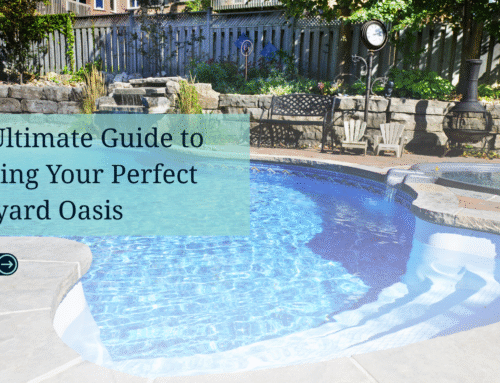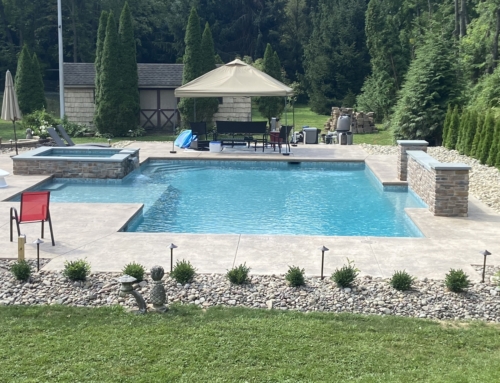As the crisp autumn air arrives, your days of splashing and swimming are likely coming to an end. While it’s sad to say goodbye to summer, proper off-season care for your pool is one of the most important things you can do as a pool owner. Simply throwing a cover over it and hoping for the best can lead to costly damage and a difficult spring opening.
This guide will walk you through why winterizing your pool is so crucial, the essential steps involved, and how professional service can protect your investment for years to come. For more information about top-quality pool care, visit B&B Custom Pools.
Why Winterizing Your Pool is a Non-Negotiable Task
Closing your pool correctly for the winter isn’t just about keeping leaves out. It’s a vital maintenance process that prevents serious problems. Cold temperatures can wreak havoc on your pool’s structure and equipment if you don’t take the right precautions.
Proper winterization helps to:
- Prevent Freeze Damage:Water expands when it freezes. If water is left in your pool’s plumbing lines, filter, pump, or heater, it can expand and crack the pipes or damage the equipment. These repairs can be expensive and complex.
- Keep Your Water Clean:A well-balanced and treated pool will stay relatively clear throughout the winter. This prevents algae blooms and bacteria growth, making your spring opening much faster, easier, and cheaper.
- Protect Your Pool Surfaces:Unbalanced water chemistry can stain or etch your pool’s plaster, vinyl liner, or fiberglass surface during the dormant months. Winterizing chemicals help maintain balance and protect these surfaces.
-
Extend Equipment Lifespan:
Properly draining and storing your pool equipment protects it from the harsh elements, ensuring it runs efficiently for many seasons.
Learn more about safeguarding your pool with our Pool Winterization Services.
The Essential Steps to Winterize Your Pool
Winterizing a pool is a multi-step process that requires attention to detail. While the exact steps can vary based on your pool type and local climate, here is a general overview of what needs to be done. For all-inclusive seasonal care, discover our Pool Service & Maintenance options.
1. Clean the Pool Thoroughly
Before you do anything else, give your pool a final, deep cleaning. This is your last chance to remove debris that could decompose over the winter, staining surfaces and feeding algae.
- Skim: Remove all floating leaves, twigs, and bugs from the surface.
- Brush: Scrub the walls and floor to dislodge any dirt or early-stage algae.
- Vacuum: Use your pool vacuum to remove all settled debris from the bottom.
A clean pool at closing means a cleaner pool at opening. Don’t skip this step.
2. Balance the Water Chemistry
Water chemistry is just as important in the off-season as it is during swim season. Unbalanced water can become corrosive or lead to scale buildup over the winter months.
A week before you plan to close, test and adjust the following levels:
- pH:4 to 7.6
- Alkalinity: 80 to 120 ppm (parts per million)
- Calcium Hardness: 200 to 400 ppm
Once these are balanced, add a “shock” treatment to eliminate any lingering contaminants. Follow the product instructions and allow the chlorine level to return to a normal range (1-3 ppm) before proceeding.
3. Add Winterizing Chemicals
After balancing the water, it’s time to add chemicals specifically designed for closing your pool. A good winterizing kit typically includes:
- Winter Algaecide: A long-lasting algaecide that prevents algae spores from blooming under the cover.
- Stain & Scale Preventer: This chemical helps prevent mineral staining and scale formation on your pool surfaces.
Circulate the water for several hours after adding these chemicals to ensure they are evenly distributed throughout the pool.
4. Lower the Water Level
To prevent freeze damage to your skimmers and tile line, you need to lower the water level. The correct level depends on your pool type and cover.
- For mesh safety covers: Lower the water 2-3 inches below the skimmer/tile line.
- For solid, floating covers: Lower the water 1 inch below the skimmer/tile line
Never drain an in-ground pool completely for the winter. The water helps support the structure and protect the liner or plaster from drying out and cracking.
5. Drain and Store Equipment
This is perhaps the most critical step for preventing costly freeze damage. All water must be removed from your equipment.
- Clear the Plumbing Lines: Use a blower or shop vac to force all water out of the skimmer and return lines. Plug the lines securely with winter expansion plugs.
- Drain the Pump, Filter, and Heater: Locate and open the drain plugs on all your equipment. Allow every drop of water to drain out.
- Store Accessories: Remove and store ladders, handrails, diving boards, and automatic pool cleaners in a dry, protected area.
Curious about the equipment and expert techniques we use? Check our Pool Equipment Solutions for further details.
6. Install Your Winter Cover
The final step is to securely place your winter cover over the pool. Make sure it is free of holes or tears and fits snugly. A quality safety cover not only keeps debris out but also prevents accidental entry into the pool, which is a crucial safety feature for homes with children or pets.
Common Winterizing Mistakes to Avoid
A small mistake during the closing process can lead to big problems in the spring. Watch out for these common errors:
- Closing Too Early: Wait until the temperature is consistently below 65°F (18°C) to close your pool. Closing when it’s still warm creates a breeding ground for algae.
- Improper Water Balance: Adding winter chemicals without first balancing the core chemistry (pH, alkalinity) makes them less effective.
- Forgetting to Clear the Lines: This is the #1 cause of cracked pipes. Even a small amount of trapped water can freeze and cause significant damage.
- Using a Simple Tarp: A standard tarp is not a safety cover. It won’t support weight and can become a hazard. Invest in a proper, well-fitting winter or safety cover.
Why Trust a Professional With Your Pool Closing?
While it’s possible to winterize your pool yourself, the process is technical and unforgiving. Hiring a professional service provides peace of mind and ensures the job is done right.
- Expertise and Experience: Professionals know exactly how to handle different types of pools, equipment, and local climate conditions.
- The Right Tools: We have specialized equipment, like powerful blowers, to guarantee every drop of water is cleared from your plumbing.
- Guaranteed Protection: When you hire a professional, you are protecting your investment against expensive freeze damage. It’s a small price to pay for security.
- Saves You Time and Hassle: The closing process can take an entire weekend. Let us handle the hard work so you can enjoy your autumn.
Protect Your Pool This Winter
Properly winterizing your pool is the best thing you can do to ensure a smooth, stress-free opening next spring. By protecting your equipment and surfaces from the harsh winter weather, you save yourself time, money, and headaches.
Don’t leave your pool’s health to chance. Our team has the experience and tools to close your pool correctly and efficiently, giving you total confidence through the off-season. Read more about our seasonal offerings on the Pool Winterization page.
Ready to schedule your professional pool winterization service? Contact us today to get on the schedule before the first freeze!
Trust B&B Custom Pools for Your Winterization Needs
When it comes to protecting your pool during the off-season, experience matters. B&B Custom Pools has been serving local pool owners for years with reliable, professional pool winterization and maintenance services. Our skilled technicians take the stress out of closing your pool, ensuring every detail is handled with care and precision.
Whether you need a custom pool design or expert pool maintenance, our team is here to help you enjoy your investment year-round.
Don’t wait until the first freeze. Contact B&B Custom Pools today to schedule your professional pool closing and rest easy knowing your pool is in the best hands possible.





